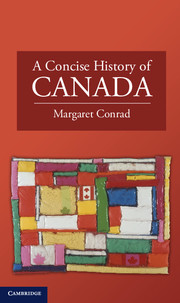Book contents
- Frontmatter
- Contents
- Illustrations
- Acknowledgements
- Introduction A Cautious Country
- 1 Since Time Immemorial
- 2 Natives and Newcomers, 1000–1661
- 3 New France, 1661–1763
- 4 A Revolutionary Age, 1763–1821
- 5 Transatlantic Communities, 1815–1849
- 6 Coming Together, 1849–1885
- 7 Making Progress, 1885–1914
- 8 Hanging On, 1914–1945
- 9 Liberalism Triumphant, 1945–1984
- 10 Interesting Times, 1984–2011
- Notes
- Guide to Further Reading
- Index
10 - Interesting Times, 1984–2011
Published online by Cambridge University Press: 05 June 2012
- Frontmatter
- Contents
- Illustrations
- Acknowledgements
- Introduction A Cautious Country
- 1 Since Time Immemorial
- 2 Natives and Newcomers, 1000–1661
- 3 New France, 1661–1763
- 4 A Revolutionary Age, 1763–1821
- 5 Transatlantic Communities, 1815–1849
- 6 Coming Together, 1849–1885
- 7 Making Progress, 1885–1914
- 8 Hanging On, 1914–1945
- 9 Liberalism Triumphant, 1945–1984
- 10 Interesting Times, 1984–2011
- Notes
- Guide to Further Reading
- Index
Summary
Neoliberal forces that had been gathering strength since the 1970s found a champion in Canada when Brian Mulroney led the Progressive Conservatives to a landslide victory in the 1984 federal election. Confronted with mounting economic challenges, Mulroney and his successors fixed their attention on new liberal orthodoxies, among them global economic competitiveness and a reduced role for the state in sustaining social welfare. As Communist regimes in Europe collapsed under the weight of their fossilized bureaucracies, efforts to create a new world order based on free-market capitalism advanced rapidly. Canada and the United States signed a Free Trade Agreement in 1988, and the World Trade Organization, which evolved from GATT in 1995, established an international framework for promoting trade liberalization. Cutting across this trajectory were other destabilizing forces, among them the digital communications revolution, climate change, and attacks on the Pentagon and the World Trade Center by Muslim extremists on 11 September 2001. Could the centre hold in such a context?
THE MARKET WELFARE STATE
Most Western nations had welcomed the enhanced power of the state in the decades following the Second World War, but there had always been critics of big government. In the United States sharp debates about economic policy had been churning since the 1950s, with Milton Friedman, an economist based at the University of Chicago, championing the neoliberal cause and the Canadian-born Harvard economist John Kenneth Galbraith supporting a larger role for governments in maintaining economic stability and social well-being. Galbraith’s perspective prevailed until the 1970s, when the oil crisis and stagflation opened the door to criticism of the welfare state. With corporate-sponsored think tanks predicting disaster if current policies continued and North American companies moving their operations to developing countries to avoid taxes, labour contracts, and environmental regulations, policymakers focused on economic restructuring to accommodate “a new world order.”
- Type
- Chapter
- Information
- A Concise History of Canada , pp. 258 - 288Publisher: Cambridge University PressPrint publication year: 2012

